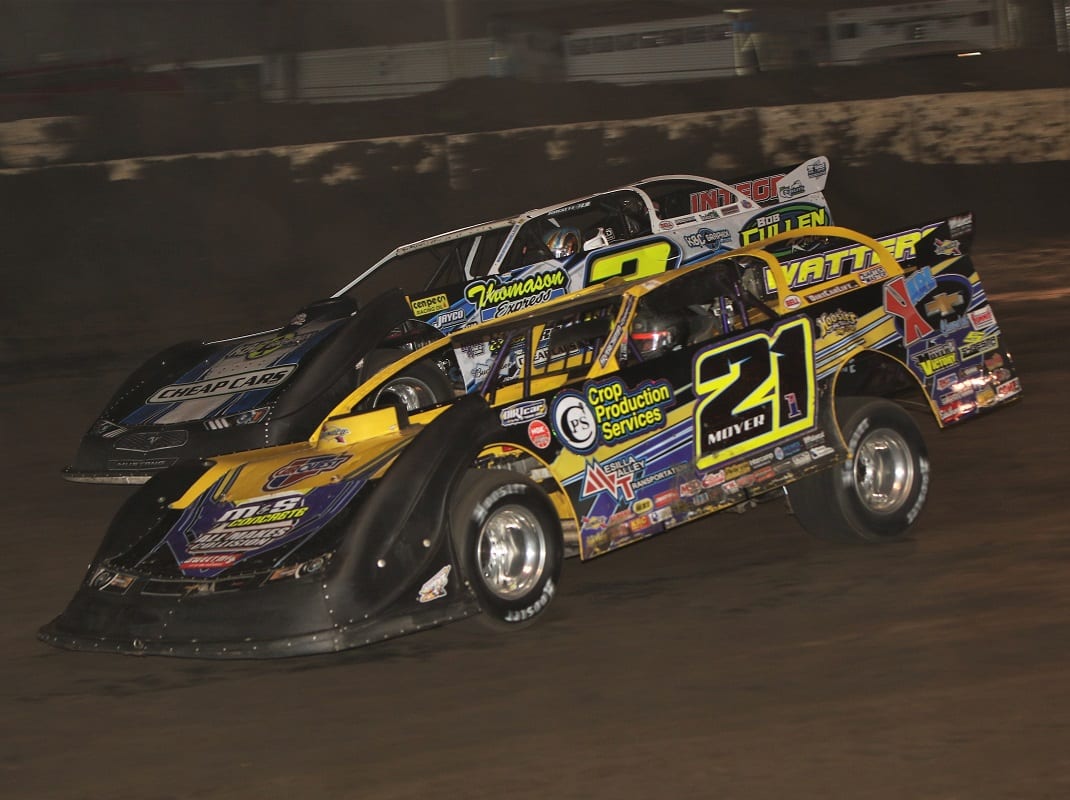After a nationwide moratorium on racing during World War II, racing returned to Fairbury in 1946 on a newly built fifth-mile, bowl-shaped midget track.
Midget racing was sweeping the nation, and the speedway reaped its share of the reward. Crowds swelled to a reported 6,500 in the mid to late ’40s. Famous drivers began to show up to compete, like Emil Andres and Tony Bettenhausen, who had both competed in the Indianapolis 500.
Midget racing became so popular in fact, new tracks were popping up all over the country. With too many tracks and not enough cars, Spud reduced the number of races at Fairbury to one each month.
In July of 1949, the AAA sanctioned their first race outside of Chicago in Illinois at Fairbury. Attracting drivers from across the country, the race played out before a packed house.
Stock cars made their arrival in 1949. At this time tracks across the country were running races with the factory produced vehicles. It was common in those days for a competitor to drive their car to the track, put on racing tires and compete in races.
Originally running a split bill with the midgets, the stock cars gradually gained popularity, but it wasn’t always smooth sailing.
Stock cars would run at least one race at the track every year from 1949 all the way to the current day, crowning 40 different champions over the 70 years.
The cars have changed quite a bit over the years. Gone are the “stock” cars, replaced with highly engineered machines touting advanced suspensions and finely tuned engines.
Today’s late model stock cars barely resemble their ancient cousins, but the spirit of competition lives on.
In 1989 it became evident that improvements were needed at the aging track. While the purse had increased to one of the largest in the area, the car count had diminished. The track was too small and the corners too tight for the bigger and faster cars of the day.
This led to single file racing, extreme difficulty passing, and many drivers moved on to other tracks where their odds of winning were higher. The low car count, in turn, drove attendance down. It was time to make a change.
Doug Aaron was a race fan and journalist who covered dirt racing in Illinois, reporting for The Pantagraph and The Daily Leader. His experience traveling to 50-plus races a year gave him concepts on what could be done to improve car count and attendance at Fairbury. He put his track design on paper and talked to the drivers.
After some feedback a final blueprint was established, and the work began.
Thanks in a large part to good weather, an army of local and regional contractors set about making the improvements to the historical facility. The race track was completely leveled using heavy equipment. The new track surface was laid out with the help of lasers and 20,000 tons of dirt that had been trucked in.
The new surface measured a third of a mile in length, with 60-foot wide straightaways and sweeping 75-foot side corners with 25-degree banking. A $25,000 state-of-the-art MUSCO Sports Lighting System was also installed, illuminating the track like it had never been seen before. The project cost $500,000 and was well received by all involved.
In the winter of 1990, Fair Board and American Legion leaders, wanting to showcase the improvements to the then 70-year-old track, decided to host two annual events in hopes of attracting the country’s best drivers.
The UMP Gold Series was renamed to the Summer Nationals, and a new feature late model race was born – the Prairie Dirt Classic.
The first Prairie Dirt Classic was run on Sept. 5, 1990, when Snooky Dehm took home the top prize. After taking the lead at lap five, he held it for 47 laps until Tom Pauley made a high side pass. Pauley’s engine would explode on the next lap, giving the lead back to Dehm, who went on to take the checkered flag.
The event has become a huge success. Today known as one of the country’s premier dirt late model races, the Prairie Dirt Classic is a crown-jewel stop on the World of Outlaws Morton Buildings Late Model Series schedule.
Touting a $93,000 purse and $30,000 to win, the PDC attracts close to 70 of the country’s top late models each year.
This year’s Prairie Dirt Classic kicks off Friday, July 26, for two days of full racing, camping and entertainment.
